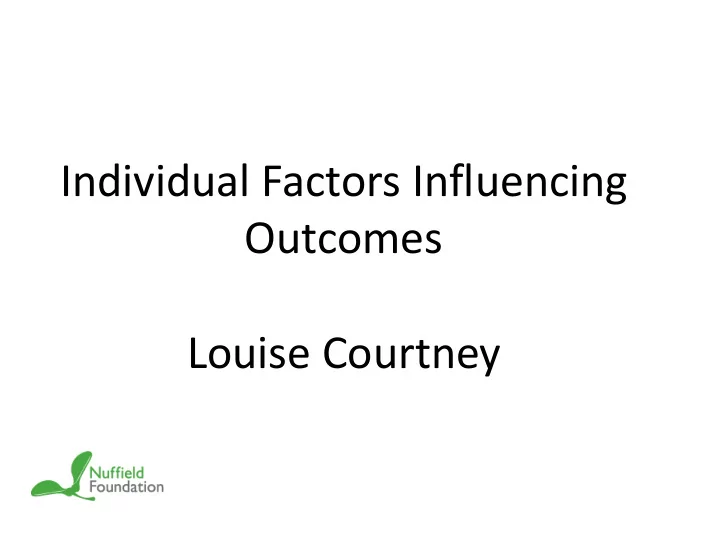

Individual Factors Influencing Outcomes Louise Courtney
Early Language Learning • The provision of early language programs is often based on the assumption (from naturalistic language learning) that young learners find language learning easier and enjoyable • Two key studies of early languages learners show that there is variability in both levels of motivation and outcomes: – Cable et al. (2010) – Evaluation of language teaching in 80 schools in England – Enever et al. (2013) – ELLiE project – European evaluation of early language learning in 7 countries including England
Individual factors - motivation Measure YR Mean & SD Range Motivation Y6 2.49 (.543) 1.26-3.74 Mean scores Y7(1) 2.85 (.45) 1.26-3.79 Y7(2) 2.97 (.53) 1-3.95 Self-Efficacy Y6 2.44 (.60) 1.08-3.62 Mean scores Y7(1) 2.71 (.52) 1-3.83 Y7(2) 2.97 (.57) 1-3.92 Learners held mainly positive attitudes to learning French, however some learners held negative views of their language learning experience and their own abilities
Individual Factors influencing results • Gender Differences – A common finding of MFL studies is that girls are more motivated than boys and that they often out-perform boys in language assessments. 4
Individual Factors influencing results • Girls displayed higher levels of motivation and self-efficacy Measure YR Boys Girls Motivation Y6 2.45 2.53 (mean score) n=110 n=123 Y7(1) 2.72 2.95* n=73 n=88 Y7(2) 2.87 3.06* n=45 n=54 Self-Efficacy Y6 2.39 2.49 (Mean Score) n=110 n=123 Y7(1) 2.58 2.83* n=73 n=88 Y7(2) 2.86 3.07* n=45 n=54
Individual Factors influencing results Girls also significantly out-performed the boys in both the SR and PT tasks over the three rounds Task Year Boys Girls Sentence Rep Y5 21.01 25.51* Mean score (sd=9.38) (sd=9.33) Y6 24.15 28.88* (sd=9.4) (9.63) Y7 28.45 32.84* (sd=9.44) (sd=8.08) Photo Des Y5 11.36 16.08* Mean Score (sd=7.45) (sd=8.11) Y6 14.07 17.8* (sd=7.83) (sd=7.31) Y7 17.75 21.33* (sd=8.49) (sd=8.12)
Individual Factors influencing results • Individual factors – English Literacy: • Previous studies have demonstrated a strong link between learners English literacy levels and L2 outcomes. • Our data show English literacy level to be the factor that correlated most strongly with attainment levels 7
Individual Factors influencing results English Literacy Overall Motivation Level Sentence Rep .540** * Y5 Photo Des Y5 .597** * Sentence Rep .640** .363** Y6 Photo Des Y6 .614** .357** Sentence Rep .618** .406** Y7 Photo Des Y7 .592** .453** 8
Individual Factors influencing results • For the SR and PT tasks English literacy accounted for 40% of the difference in learner scores across Years 5-7 • An additional 15-20% of the difference is explained by school related factors such as teaching time and teacher training • Motivation accounted for a further 3-4% of the difference in learner outcomes
Individual Factors influencing results • No difference in learners under different conditions (literacy vs. oracy) • However we wanted to see how learners from with different levels of English literacy abilities performed under the different conditions and if there were any differences in their levels of motivation • We grouped the learners into 3 groups (high, mid, low) based upon their levels for reading and writing in primary school
Results – English literacy, motivation and self-efficacy The learners with higher levels of English literacy displayer higher levels of motivation and self-efficacy in years 6 and 7 Motivation Motivation Motivation Self-efficacy Self-efficacy Self-efficacy Y6 Y7(1) Y7(2) Y6 Y7(1) Y7(2) Low 2.17 2.44 2.29 1.99 2.13 2.18 (SD=.55) (SD=.38) (SD=.37) (SD=.57) (SD=.43) (SD=.51) n=18 N=9 N=5 n=18 N=9 N=5 Mid 2.42 2.78 2.92* 2.35* 2.63* 2.88* (SD=.51) (SD=.47) (SD=.53) (SD=.56) (SD=.51 (SD=.54) N=120 N=79 N=43 N=120 N=79 N=43 High 2.65* 2.96* 3.08 2.64* 2.88* 3.13 (SD=.51) (SD=.40) (SD=.50) (SD=.59) (SD=.47) (SD=.57) N=95 N=73 N=51 N=95 N=72 N=51
Results – Gender task by learners with high English literacy levels in different conditions 8 7 6 5 High-Literacy 4 High-Oracy 3 2 1 0 GY5 GY6 GY7 12
Results – Gender task by learners with mid English literacy levels in different conditions 7 6 5 4 Mid-Literacy Mid-Oracy 3 2 1 0 GY5 GY6 GY7 13
Results – Gender task by learners with low English literacy levels in different conditions 8 7 6 5 Low-Literacy 4 Low-Oracy 3 2 1 0 GY5 GY6 GY7 14
Results – Sentence Repetition task by learners of all English literacy levels in different conditions 40 35 30 25 Low-Literacy Low-Oracy Mid-Literacy 20 Mid-Oracy High-Literacy 15 High-Oracy 10 5 0 SRY5 SRY6 SRY7 15
Results – Photo Description task by learners of all English literacy levels in different conditions 30 25 20 Low-Literacy Low-Oracy Mid-Literacy 15 Mid-Oracy High-Literacy High-Oracy 10 5 0 PTY5 PTY6 PTY7 16
Conclusions • Huge variability in learner outcomes both in primary and secondary school • Learners held general positive attitudes to language learning but some aspects of PLs were disliked and some learners displayed low levels of motivation and self-efficacy • Motivation and English literacy levels all had a significant relationship with outcomes
Conclusions • English literacy levels became increasingly related to L2 outcomes and motivation by the end of Y7 with a widening gap between least and most able pupils • Results highlight the reciprocal nature of the relationship between English literacy, motivation and L2 outcomes even at the earliest stages of language learning
Conclusions • Emerging evidence that a more literacy-based approach in primary school may help lower ability learners • The written form could assist these learners by serving as prop to: – help them retain and recall words – to notice patterns in language input – help them be better prepared for the more literacy-focused pedagogy in secondary school
Conclusions • Aim of PLs is to lay the foundation for future language learning in terms of motivation and outcomes • It is therefore essential to accept that there is variability in terms of outcomes and attitudes and tackle it head-on so that all learners are able to make some progress
Recommend
More recommend